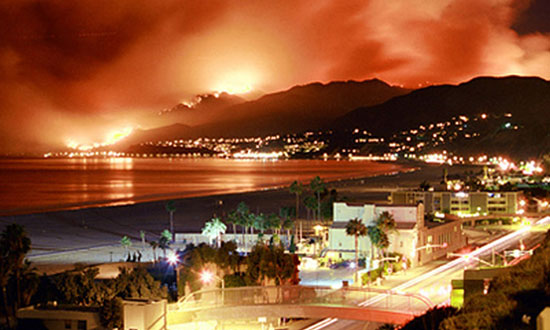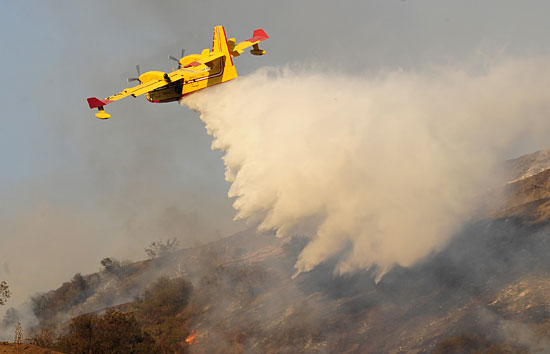Historic fire’s legacy lives on
August 28, 2013

The Old Topanga Fire drove home the need for Super Scoopers. Topanga Messenger photo/Martin Nate Rawner
The first spark was sighted at 10:46 a.m. on the first Tuesday of November, 1993. It was hot. The Santa Anas were gusting. Fires had just consumed swaths of Altadena and Laguna Beach, and now came a 911 call to report a fire on Old Topanga Canyon Road, near the water tower. Minutes later, the smoke could be seen from a half-mile away.
Over the course of 10 days, the Old Topanga Fire would consume 16,516 acres, killing three people and injuring 21 others. Some residents will never forget the way it exploded through Malibu, hopping from canyon to canyon, cresting Saddle Peak in a 200-foot-long wall of flame.
But the fire also made another kind of history in Los Angeles County. In the wake of its devastation, the county became the first jurisdiction in California to begin regularly leasing the Canadian tanker planes known as “Super Scoopers”—a move for which firefighters were particularly grateful this week as a far-earlier-than-usual fire season hit Yosemite National Park, scorching a wilderness area the size of Chicago.
“The fires this year have been extreme,” says Los Angeles County Fire Chief Daryl Osby, citing the hundreds of fires that occurred this year throughout California. The Springs Fire struck in May, and then came June’s Powerhouse Fire, which destroyed more than 32,000 acres and some two dozen houses near Lake Hughes in a month that, in past years, has always been cool and foggy.
Lower-than-usual rainfall and a lack of June gloom, he says, have made the canyons as dry now as they usually are in autumn, when the Santa Ana winds typically turn L.A.’s canyons into fire hazards. Worse, the county hasn’t had a major fire since 2009, meaning that the county has mountains of parched vegetation to burn.
All of this, meanwhile, comes in the midst of a three-year drought that has disrupted conventional fire patterns. How much it all has to do with climate change is beyond his expertise, the chief says, but the upshot has been a new kind of fire season—bigger, earlier, less predictable and more lethal than ever.
“The Powerhouse Fire burned like it was September, and it wasn’t even being pushed by Santa Anas,” he says. “I can’t say yet whether this season is going to be the worst ever, but the potential is there.”
That, he says, is why the county moved up this year’s timeline by a full month for arrival of the Bombardier CL-415 Super Scoopers that it has leased for the past 19 years from the government of Quebec. Able to fly at speeds of up to 170 mph, the iconic yellow planes dip into oceans and lakes, pulling in 1,620 gallons of water in 12 seconds to dump from the air onto brushfires—a powerful tool for which canyon dwellers lobbied mightily after the 1993 fire.
“We’ve known since probably around February that we had the potential for a volatile fire season,” says Osby. “When we saw in June that the fuel moisture levels in our vegetation were already down to what we would normally see in September, we started collaborating with Quebec to see how early we could get the Super Scoopers.”
The planes arrived with their Canadian crews on August 15, as opposed to their usual start date in mid-September, and already they have been deployed on brushfires in Topanga and Calabasas.
“Your fire conditions in L.A. are worse than in the past years,” says Chief Pilot Carl Villeneuve, who expects to remain with the two leased planes until mid-December, if not longer. “Those two fires weren’t hard to put out because there are no big winds yet, but when the big winds come, that could change.”
Osby says the early Super Scooper deployment is just one part of a strategy to pre-empt a potentially lethal autumn. (The two planes were joined by an Erickson Air-Crane Helitanker, also contracted this year for extra backup.)
“We have also been aggressive with our fire prevention inspections, and in working with citizens to ensure proper brush clearance,” the fire chief says. “We provided additional training to our firefighters, getting them out to wild lands for practice. We did additional simulations with surrounding agencies, and intensified training with our incident management teams.”
The department has been urging the public to be vigilant, to become familiar with the department’s “Ready! Set! Go!” program and to evacuate when fire officials tell them to get out of a threatened area, rather than stick around to try to guard their houses.
“Our response capability is better now than it was 20 years ago,” Osby says. “We have additional aircraft, more sophisticated training and better weather predictions.”
Posted 8/28/13













 405 bridge work causes a stink
405 bridge work causes a stink
